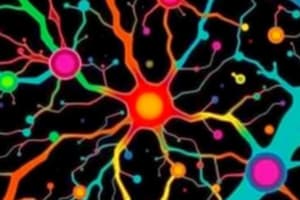Podcast
Questions and Answers
What are the main differences between genetic algorithms (GA) and particle swarm optimization (PSO)?
What are the main differences between genetic algorithms (GA) and particle swarm optimization (PSO)?
- GA involves genetic operations like crossover and mutation, while PSO involves updating particle velocities based on the best fitness values.
- GA uses a population-based approach, while PSO uses a swarm-based approach. (correct)
- GA searches the solution space using velocity and position updates, while PSO searches for solutions by evolving a population of candidate solutions.
- GA focuses on finding optimal solutions through natural selection, while PSO focuses on optimization through simulating the social behavior of bird flocks.
How can machine learning improve the performance of an intelligent system over time?
How can machine learning improve the performance of an intelligent system over time?
- By avoiding learning from analogies and examples.
- By sticking to a fixed set of rules and not adapting to changes.
- By relying solely on genetic algorithms for optimization.
- By adapting to new examples and experiences. (correct)
What is the definition of a neural network?
What is the definition of a neural network?
- A model that does not involve interconnected nerve cells.
- A model that consists of disconnected information-processing units.
- A model that relies on a fixed set of rules for decision-making.
- A model of reasoning based on the human brain. (correct)
What constitutes the processing power of the human brain?
What constitutes the processing power of the human brain?
What are the components of a neuron?
What are the components of a neuron?
Flashcards are hidden until you start studying
Study Notes
Optimization Algorithms
- Genetic Algorithm (GA) and Particle Swarm Optimization (PSO) are two distinct optimization techniques
- GA is a heuristic search algorithm inspired by Charles Darwin's theory of natural evolution, using processes like mutation, selection, and crossover to search for optimal solutions
- PSO is a population-based optimization algorithm that uses a swarm of particles to search for optimal solutions, inspired by the social behavior of bird flocking and fish schooling
Machine Learning
- Machine learning enables an intelligent system to improve its performance over time by learning from data and experiences
- Through machine learning, an intelligent system can adapt to new situations, improve its accuracy, and make better decisions
Neural Networks
- A neural network is a machine learning model inspired by the structure and function of the human brain
- Neural networks consist of interconnected nodes or "neurons" that process and transmit information
Human Brain Processing Power
- The human brain's processing power is attributed to its estimated 86 billion neurons, each connected to thousands of other neurons
- The human brain's neural network is thought to process information at a rate of exaflops (1 exaflop = 1 billion billion calculations per second)
Neuron Components
- A neuron consists of dendrites (receive signals), cell body (processes information), axon (transmits signals), and terminal buttons (release neurotransmitters)
- Neurotransmitters are chemical messengers that transmit signals from one neuron to another
Studying That Suits You
Use AI to generate personalized quizzes and flashcards to suit your learning preferences.





